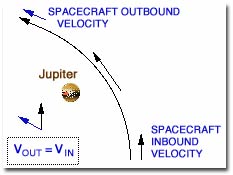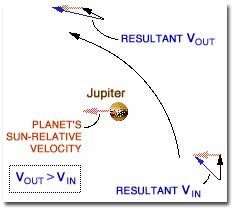Gravitational slingshot
|
|
In orbital mechanics and aerospace engineering, a gravitational slingshot is the use of the motion of a planet to alter the path and speed of an interplanetary spacecraft. It is a commonly used maneuver for visiting the outer planets, which would otherwise be prohibitively expensive, if not impossible, to reach with current technologies.
Consider a spacecraft on a trajectory that will take it close to a planet, say Jupiter. As the spacecraft approaches the planet, Jupiter's gravity will pull on the spacecraft, speeding it up. After passing the planet, the gravity will continue pulling on the spacecraft, slowing it down. The net effect on the speed is zero, although the direction may have changed in the process.
So where is the slingshot? The key is to remember that the planets are not standing still, they are moving in their orbits around the Sun. Thus while the speed of the spacecraft has remained the same as measured with reference to Jupiter, the initial and final speeds may be quite different as measured in the Sun's frame of reference. Depending on the direction of the outbound leg of the trajectory, the spacecraft can gain a significant fraction of the orbital speed of the planet. In the case of Jupiter, this is over 13 km/s. A slingshot may be simulated by rolling a steel ball past a magnet in one hand that is then moved away. Because both masses must not cross paths, the acceleration is oblique to the field and thus is similar to a sail vehicle tacking to work against the force.
It is important to understand how spacecraft move from planet to planet. The simplest way to solve this problem is to use a Hohmann transfer orbit, an elliptical orbit with the Earth at perigee and Mars at apogee. If you arrange the timing correctly the spacecraft will arrive at the outer end of its orbit right as Mars is passing by. These types of transfers are commonly used, e.g., for moving between orbits over the Earth, Earth-Moon and Earth-Mars transfers.
A Hohmann transfer to the outer planets requires long times and considerable "delta V", the sum of the changes in velocity needed at either end of the transfer orbit. This is where the slingshot finds its most common applications. Instead of the Hohmann trajectory directly to, say Saturn, the spacecraft is instead sent in a path that is aimed only as far as Jupiter, and the slingshot is then used to accelerate the spacecraft on towards Saturn. In doing so, even small amounts of fuel spent in positioning and accelerating the spacecraft on its way to Jupiter will be magnified many times once it arrives. Such missions require careful timing, which is why you often hear references to a launch window when discussing them.
A Hohmann transfer to Saturn would require a total of 15.7 km/s delta V (disregarding Earth's and Saturn's own gravity wells) which is not within the capabilities of our current spacecraft boosters. A trip using multiple gravitational assists may take longer, but will use considerably less delta V, allowing a much larger spacecraft to be sent. Such a strategy was used on the Cassini probe, which was sent past Venus, Venus again, Earth, and finally Jupiter on the way to Saturn. The 6.7-year transit is slightly longer than the six years needed for a Hohmann transfer, but cut the total amount of delta V needed to about 2 km/s, so much that the large and heavy Cassini was able to reach Saturn even with the small boosters available.
Another example is Ulysses, the ESA spacecraft which studied the polar regions of the Sun. All the planets orbit roughly in a plane aligned with the equator of the Sun; to move to an orbit passing over the poles of the Sun, the spacecraft would have to change its 30 km/s of the Earth's orbit to another trajectory at right angles to the plane of the Earth's orbit, a task impossible with current spacecraft propulsion systems. Instead the craft was sent towards Jupiter, aimed to arrive at a point in space just "in front" and "below" the planet.
As it passed the planet, the probe 'fell' through Jupiter's gravity field, borrowing a minute amount of momentum from the planet; after it had passed Jupiter, the velocity change had bent the probe's trajectory up out of the plane of the planetary orbits, placing it in an orbit that passed over the poles of the Sun, rendering that region visible to the probe. This manoeuvre required only enough fuel to send Ulysses to a point near Jupiter, which is well within current technologies.
| Contents |
Powered slingshots
A well-established way to get more energy from a slingshot is to fire a rocket engine near the periapsis to increase the spacecraft's speed. Although a given rocket burn will provide a the same change in velocity (delta-v) regardless of when it occurs, the resulting change in kinetic energy is proportional to the velocity. Therefore, to maximize the effect of the burn, gaining the most kinetic energy for the propellant expended, the burn must occur at the moment when the velocity is at its maximum, which occurs at periapsis.
If the ship travels at velocity <math>v<math> at the start of a burn that changes the velocity by <math>\Delta v<math>, then the change in specific orbital energy (SOE) is:
- <math>v \Delta v + \frac{(\Delta v)^2}{2}<math>
Once the space craft is far from the planet again, the SOE is entirely kinetic, since gravitational potential energy tends to zero. Therefore, the larger the <math>v<math> at the time of the burn, the greater the final kinetic energy, and the higher the final velocity.
For example, a Hohmann transfer orbit from Earth to Jupiter brings a space craft into a hyperbolic flyby of Jupiter with a periapsis velocity of 60 km/s, and a final velocity (asymptotic residual velocity) of 5.6 km/s, which is 10.7 times slower. That means a burn that adds one joule of kinetic energy when far from Jupiter would add 10.7 joules at periapsis. Every 1 m/s gained at periapsis adds <math>\sqrt{10.7} = 3.3<math> m/s to the space craft's final velocity. Thus, Jupiter's immense gravitational field has tripled the effectiveness of the space craft's propellant.
See also specific energy change of rockets:
- <math>\Delta \epsilon = \int v\, d (\Delta v)<math>
where <math>\epsilon<math> is the specific energy of the rocket (potential plus kinetic energy) and <math>\Delta v<math> is a separate variable, not just the change in <math>v<math>.
Limits to slingshot use
The main practical limit to the use of a slingshot is the size of the available masses in the mission.
Another limit is caused by the atmosphere of the available planet. The closer the craft can get, the more boost it gets, because gravity falls with the square of distance. If a craft gets too far into the atmosphere, the energy lost to friction can exceed that gained from the planet.
Slingshots using the Sun itself are impossible, since the Sun's gravity is directed toward its own center, and is therefore incapable of donating any angular momentum. However, thrusting when near the Sun has the same effect as the powered slingshot described above. This has the potential to magnify a space craft's thrusting power enormously, but is limited by the space craft's ability to resist the heat.
There's also another, theoretical limit based on general relativity. If a spacecraft gets close to the Schwarzschild radius of a black hole (the ultimate gravity well), space becomes so curved that slingshot orbits require more energy to escape than the energy that could be added by the black hole's motion.
On the other hand, a spinning mass produces frame-dragging. A spinning black hole actually is surrounded by a region of space, called the ergosphere, within which standing still (with respect to the black hole's spin) is impossible, as space itself slips in the same direction as the black hole's spin at the speed of light. Suffice it to say that there is a subtle relativistic effect which can transfer angular momentum between any spinning mass and a passing object.
See also
External links
- Slingshot effect (http://www.dur.ac.uk/bob.johnson/SL/)
- Animation of Cassini Huygens gravitational sling shot (http://www.esa.int/esaCP/SEMXLE0P4HD_index_0.html)
- Gravitational Slingshot Theory (http://www.mathpages.com/home/kmath114.htm)
- Gravitational Assist from Planets (http://www.go.ednet.ns.ca/~larry/orbits/orbits.html)
- A Quick Gravity Assist Primer (http://saturn.jpl.nasa.gov/mission/gravity-assist-primer.cfm)cs:Gravitační prak
de:Swing-by es:Asistencia gravitatoria fr:Appui gravitationnel nl:Zwaartekrachtsslinger ja:スイングバイ ru:Гравитационный манёвр



